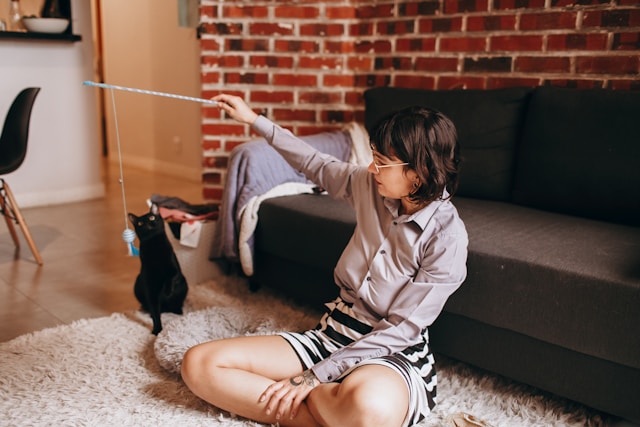Keeping pets entertained indoors is just as important as outdoor play, especially for owners who live in apartments, deal with bad weather, or have busy schedules. Pets need mental and physical stimulation to stay happy, prevent boredom, and avoid destructive behaviors. Fortunately, there are many fun and creative indoor activities to keep pets stimulated, whether you have an energetic dog, a curious cat, or even smaller pets like rabbits and guinea pigs.
Why Indoor Stimulation Matters for Pets
Pets that don’t get enough activity can become restless, anxious, or even unhealthy. Dogs may chew on furniture, while cats might scratch excessively or overeat. By introducing indoor games for pets, you can provide an outlet for their energy, strengthen your bond, and improve their overall well-being.
Mental stimulation for dogs and cats is just as important as exercise. Brain games and puzzles encourage problem-solving and keep pets sharp, while physical play helps them release pent-up energy. A mix of both is the best way to keep them engaged.
Interactive Playtime Ideas
One of the easiest ways to keep pets entertained indoors is through interactive play. Dogs love fetch and tug-of-war, which can be adapted to smaller spaces with soft toys. Cats thrive on games that mimic hunting, like chasing feather wands or laser pointers.
Hide-and-seek is another fun activity. You can hide behind furniture or place your pet’s favorite toy in a room and encourage them to find it. These games provide both exercise and mental engagement while strengthening your connection with your pet.
Puzzle Toys and Food Games
Puzzle feeders and treat-dispensing toys are excellent tools for mental stimulation. They encourage pets to work for their food, slowing down mealtime and providing enrichment. For dogs, try stuffing a Kong with peanut butter or kibble. Cats enjoy ball-shaped feeders that release treats as they roll them around.
DIY food games are another option. Hide kibble or small treats in different rooms, under cups, or inside cardboard boxes to create a mini scavenger hunt. This type of activity satisfies your pet’s natural instincts and keeps them busy for longer periods.
Training and Obedience Exercises
Training sessions are a great way to provide indoor stimulation while reinforcing good behavior. Teaching new tricks such as “shake,” “spin,” or “roll over” not only challenges your pet mentally but also boosts their confidence.
Short, consistent sessions are best, especially for dogs. For cats, clicker training can be surprisingly effective, allowing you to teach fun behaviors like high-fives or jumping through hoops. This approach keeps pets mentally engaged while building trust.
DIY Indoor Pet Activities
If you’re feeling creative, you can set up an indoor obstacle course. Use chairs, cushions, or boxes to create tunnels and jumps for your dog. Cats love climbing towers, scratching posts, and tunnels, which allow them to practice their natural climbing and hiding instincts.
Agility training indoors can also be a great way to tire out active dogs. Even simple setups using broomsticks, pillows, or laundry baskets can provide hours of fun.
Calming and Enrichment Activities
Not all indoor activities need to be high-energy. Some pets benefit from calming enrichment that engages their senses. Snuffle mats are perfect for scent-based play, allowing dogs to “forage” for treats hidden in fabric layers. Cats may enjoy sensory play with different textures, pet-safe bubbles, or even catnip toys.
Chew toys are another excellent option for dogs, satisfying their natural chewing instinct while keeping them relaxed.
Tips for Keeping Pets Engaged Indoors
-
Rotate toys regularly so pets don’t get bored.
-
Mix physical and mental play to balance their energy.
-
Choose activities based on your pet’s age, breed, and health. Puppies may need more physical games, while older pets might prefer puzzles and gentle interaction.
-
Make it part of your routine so your pet looks forward to playtime every day.
Conclusion
There are countless indoor activities to keep pets stimulated, from interactive games and puzzle feeders to training sessions and DIY obstacle courses. The key is providing a balance of physical exercise and mental enrichment so your furry friend stays happy and healthy. By incorporating these activities into daily life, you can strengthen your bond and create a more engaging environment for your pet, no matter the weather or living situation.

